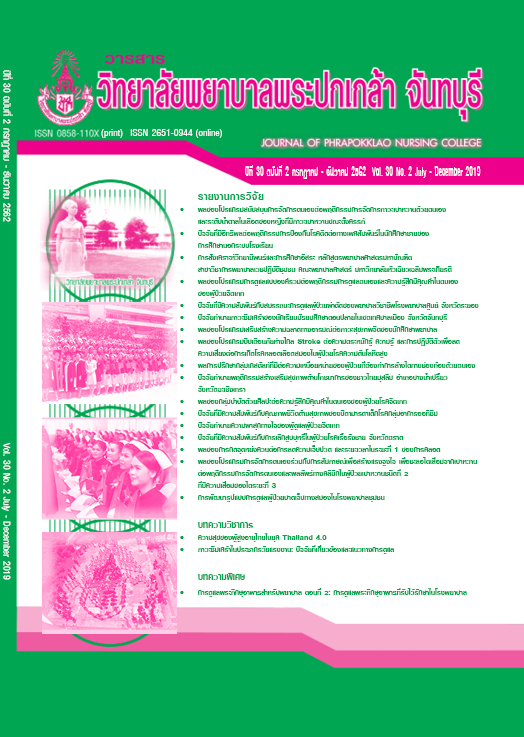The Development of Nursing Care Model for Traumatic Brain Injury Patients in Community Hospital
Keywords:
Nursing care model, Traumatic brain injury, Community hospitalAbstract
This research and development aimed to develop a nursing care model for traumatic brain injury patients in community hospital and to examine its effectiveness. The samples were composed of 15 traumatic brain injury patients receiving treatment at an emergency department of Khaosukim Hospital, and 12 registered nurses. The research instruments comprised a nursing care model for traumatic brain injury patients in community hospital, a provider’s handbook of nursing care for traumatic brain injury patients in community hospital, a self-education brochure, a recording form of demographic data, an assessment form of nursing care for traumatic brain injury patients in community hospital, and a questionnaire of client satisfaction on nursing care model with the reliability of .80. The implementation and data collection were conducted through 5 steps including: 1) collect and analyze data, 2) develop the model, 3) try out the model, 4) improve and develop the model, 5) test and evaluate the effectiveness of the model from February to April, 2019. Frequency, percentage, and content analysis were used for data analysis.
The research results revealed that the nursing care model for traumatic brain injury patients at community hospital included 4 processes: 1) screening 2) monitoring and continuing care 3) referring, and 4) discharge. After implementing the model at the first time, almost traumatic brain injury patients had incomplete nursing care because the providers did not profoundly understand about a nursing care model for traumatic brain injury patients. After using the second developed model, all traumatic brain injury patients received complete care, and had no complications from delayed medical treatment and did not have complications from brain injury.
This research suggests that the registered nurses in community hospitals should apply this nursing care model for traumatic brain injury patients as a guideline for care and preventing complications in traumatic brain injury patients, especially in those with low risk and moderate risk in mild traumatic brain injuries.
References
งานการพยาบาลผู้ป่วยอุบัติเหตุฉุกเฉินและนิติเวช โรงพยาบาลเขาสุกิม จังหวัดจันทบุรี. (2559). สถิติผู้ป่วยที่มารับบริการ (ER visit) ปีงบประมาณ 2559. จันทบุรี: ผู้แต่ง.
บุบผา ลาภทวี, และจิณพิชญ์ชา มะมม. (2558). ปัจจัยทำนายระดับการเฝ้าระวังและป้องกันภาวะเลือดออกในสมองของผู้ป่วยบาดเจ็บที่ศีรษะเล็กน้อย โรงพยาบาลธรรมศาสตร์เฉลิมพระเกียรติ. วารสารวิทยาศาสตร์และเทคโนโลยี, 23(6), 1023-1032.
รัตนา กองสุทธิผล, และอริยาวรรณ วรรณสีทอง. (2560). ผลการใช้แนวทางการดูแลผู้ป่วยบาดเจ็บที่ศีรษะเล็กน้อย. สืบค้นจาก https://www.cbh.moph.go.th
ราชวิทยาลัยศัลยแพทย์แห่งประเทศไทย. (2551). แนวทางการรักษาพยาบาลผู้ป่วยทางศัลยกรรม: บาดเจ็บที่ศีรษะ (Head injury). สืบค้นจาก https://www.rcst.or.th
วิบูลย์ เตชะโกศล. (2557). ประสิทธิผลของการพัฒนาระบบทางด่วนพิเศษในผู้ป่วยบาดเจ็บที่ศีรษะ. ศรีนครินทร์เวชสาร, 29(6), 524-529.
สถาบันการแพทย์ฉุกเฉินแห่งชาติ. (2562). คู่มือแนวทางการบริหารจัดการระบบการแพทย์ฉุกเฉินระดับจังหวัด ฉบับที่ 1 พ.ศ. 2562. นนทบุรี: ปัญญมิตรการพิมพ์.
สวิง ปันจัยสีห์, นครชัย เผื่อนปฐม, และกุลพัฒน์ วีรสาร. (2556). แนวทางเวชปฏิบัติกรณีสมองบาดเจ็บ. กรุงเทพฯ: ธนาเพรส.
อัญชลี ถิ่นเมืองทอง, อรทัย ศิลป์ประกอบ, ศรีวรรณ มีบุญ, และเยาวรัตน์ รุ่งสว่าง. (2559). การพัฒนาระบบการพยาบาลผู้ป่วยบาดเจ็บที่ศีรษะจากอุบัติเหตุทางถนนในโรงพยาบาลปทุมธานีโดยใช้แนวคิดการพยาบาลผู้จัดการรายกรณีในห้องอุบัติเหตุและฉุกเฉิน. วารสารกองการพยาบาล, 43(3), 5-24.
Dams-O’Connor, K., Landau, A., Hoffman, J., & St De Lore, J. (2018). Patient perspectives on quality and access to healthcare after brain injury. Brain Injury, 32(4), 431-441.
Johnson, W. D., & Griswold, D. P. (2017). Traumatic brain injury: A global challenge. The Lancet Neurology, 16(12), 949-950.
Katz, D., & Kahn, R. L. (1978). The social psychology of organizations (2nd ed.). New York: Wiley.
National Institute of Child Health and Human Development. (2016). Traumatic brain injury. Retrieved from https://www.nichd.nih.gov/health/topics/tbi
Downloads
Published
How to Cite
Issue
Section
License
เนื้อความ ข้อมูล และรายการอ้างอิงที่ผู้เขียนใช้ในการเขียนบทความเพื่อลงตีพิมพ์ในวารสารวิทยาลัยพยาบาลพระปกเกล้า จันทบุรี ถือเป็นความคิดเห็นและความรับผิดชอบของผู้เขียน คณะผู้จัดทำวารสารไม่จำเป็นต้องเห็นพ้องด้วยหรือร่วมรับผิดชอบ
บทความที่ได้รับการลงตีพิมพ์ในวารสารวิทยาลัยพยาบาลพระปกเกล้า จันทบุรี ถือเป็นลิขสิทธิ์ของวารสารวิทยาลัยพยาบาลพระปกเกล้า จันทบุรี หากหน่วยงานหรือบุคคลใดต้องการนำส่วนหนึ่งหรือทั้งหมดของบทความไปเผยแพร่ต่อเพื่อวัตถุประสงค์ใด ๆ จะต้องได้รับอนุญาตจากบรรณาธิการวารสารก่อน



